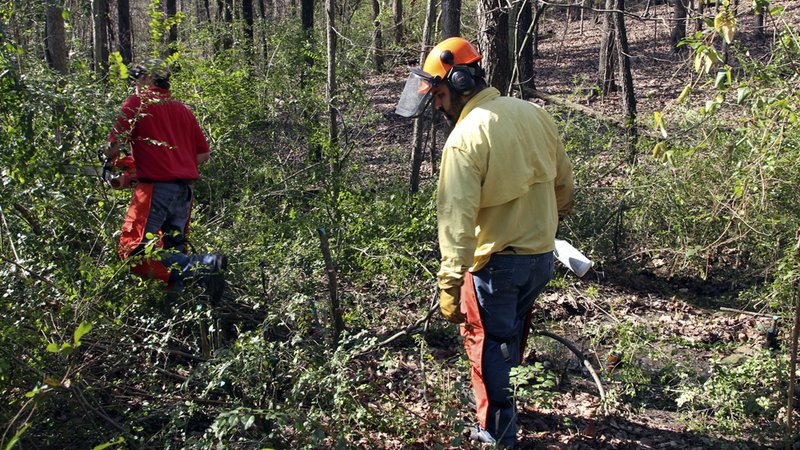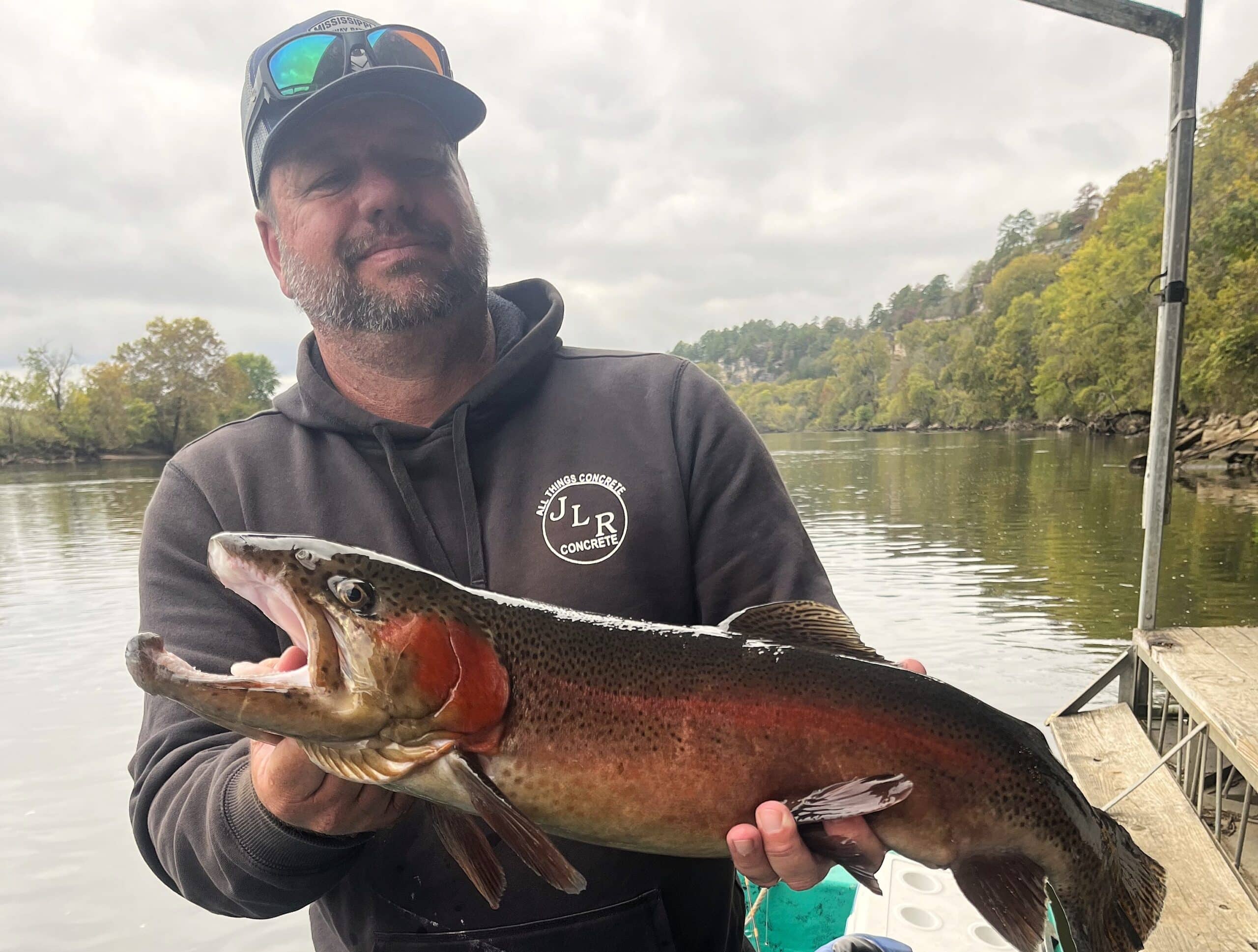Forest thinning important tool for wildlife management
ON 06-28-2017

June 28, 2017
Randy Zellers
Assistant Chief of Communications
That ancient oak standing amongst a crowded forest canopy may look like the perfect magnet for deer, but that tree may not be the best use of space for wildlife in the long run. Selectively removing some damaged, old and less productive trees is part of healthy forest management and necessary to begin the next generation of forest for our children to enjoy.
Martin Blaney is the statewide habitat program coordinator for the AGFC. He’s heard from many concerned hunters and even state representatives about logging operations to improve wildlife habitat on wildlife management areas during his 31 years with the Commission. He explains that money is not the motivation behind any timber harvest on WMAs. It’s about offering a variety of species and ages throughout the forest to benefit the wildlife now and in the future.
“The first thing I usually ask someone who visits one of these sites is for them to tell me where the young oaks are underneath the taller trees,” Blaney said. “There aren’t any because the forest canopy is ‘closed,’ blocking most of the sunlight. Oaks don’t grow in the shade, so you have to create holes in the canopy and let sunlight hit the forest floor. That way we have a better chance of replacing this forest with oaks and have a good mix of ages within the same stand.”
By varying the ages and density of individual trees, habitat biologists are able to create more habitat conditions suitable for a variety of game and nongame animals, while managing those forests for the future.
“If all of the trees in a forest are the same age, called ‘even-aged’ management, when productivity decreases in those dominant trees, there’s nothing available to take their place,” Blaney said. “Instead of having to start over from the beginning by clearcutting, we use uneven-aged forest management and try to keep a constant supply of the next generation of shade intolerant trees, like oaks, growing to fill that need.”
Blaney is the first to admit that some areas can look very rough after a logging operation. The unsightly remains are temporary, and often beneficial to wildlife. Slash piles and downed tops create nesting and escape cover for many species of birds as well as bedding cover and shelter for deer fawns, rabbits and other game animals. Trees, shrubs and other ground plants that form in the next year from the sunlight reaching the ground offer food to wildlife long after the fall crop of acorns has been eaten. After a year or two, perennial plants, vines and shrubs continue offering valuable habitat, with the next generation of oaks in the mix.
“Eventually those holes we created through logging will contain adequate amounts of oaks ready to replace the canopy of the forest, and other holes we create during that transition will be at other stages in development,” Blaney said. “This way you always have a mature dominant class, a midstory, and new openings being created to continue the process.”
Blaney says this type of uneven-aged management called “wildlife forestry” is part of a larger initiative from the partnerships of the Lower Mississippi Valley Joint Venture, focused specifically on bottomland hardwood restoration.
“Many private lands that are primarily interested in managing their forest for income tend to use even-aged management where stands are clearcut and planted, but we aren’t managing our forests for money,” Blaney said. “We are trying to maintain desired forest conditions that promote abundant wildlife habitat. As a result, we can sell the trees that need harvesting to local timber buyers. I tell folks that we don’t give away state property, it wouldn’t be good stewardship.”
The AGFC receives revenue from forest thinnings on WMAs, but money is not the motivation for the harvest. Statewide forest revenues for the last three years averaged about $660,000, which is about 0.75 percent of the AGFC’s total revenue.
“It’s what we do with the money we receive that counts. That money goes into a special budget category that’s devoted to additional habitat improvement on statewide WMAs,” Blaney said.
Blaney says money derived off WMAs must go back into habitat management, because all of Arkansas’s WMAs were purchased with the help of federal matching grants. However, the money does not necessarily go back to the exact WMA in which the logging occurred.
“Some WMAs don’t have the forests or markets that allow for generating dollars, but we still need to conduct habitat management,” Blaney said. “Projects like forest inventories, prescribed fires, herbicide treatments, and timber marking all require money, and with the hundreds of thousands of acres we manage, we rely heavily on private contractors for much of those needs. There’s also road maintenance, bush-hogging to maintain wildlife openings and other open land management that must be conducted each year.”
Some hunters and preservation-minded individuals have voiced concerns over cutting what they believe is “virgin” or pristine forests, but Blaney says the romantic notion of untouched forestlands simply does not exist on AGFC WMAs. American Indians set fires and manipulated the landscape to fit their needs, and settlers converted many acres of forests into agricultural land during westward expansion. Other forested areas were manipulated to produce timber more efficiently, and many bottomland hardwoods have seen manipulations to benefit waterfowl and other wildlife.
“Just about all of the forestlands on WMAs the AGFC owns were either logged prior to purchase or had “cutting” contracts in the agreements at the time we bought them,” Blaney said. “Most of the forests hunters currently enjoy on our WMAs are only about a century old. That’s the reason there are so many red oaks at the same age out there right now. The cutting allowed massive amounts of sunlight to hit the ground and start the forests we’ve inherited.”
Sheffield Nelson Dagmar WMA is a good example of a WMA that seems ancient, but is actually relatively young from a forestry perspective. The soil there can grow an oak that’s 28 inches in diameter in less than 80 years.
“Almost all of that property was harvested in the 50s; even much of the cypress,” Blaney said. “Men would cut those cypress down using saws from john boats then float them out. There are a bunch of ancient trees out there left, but they were left behind because they were hollow or of poor-quality for lumber.”
Blaney also points out that one or two people are not responsible for the decisions when it comes to harvesting forest products from WMAs. Instead, a comprehensive forest inventory is conducted and a prescription for management is formulated detailing needed treatments. Everyone from the area manager, to the regional biologist, all the way up to Blaney and the chief of wildlife management for the AGFC has to sign off on these prescriptions before any cutting can take place.
“We try to take out species of trees in the same percentages that comprise the current forest,” Blaney said. “That way we aren’t shifting the composition away from the tree species that are there. It may seem like only good oaks are being removed if you were to look at a logging truck on the site, but those logging trucks are loaded to go to mills, so they separate the grades and species of the trees before loading to send the trees to the different mills that will handle those species at the best price to the logger.
“Our forests need to be managed, so they don’t transition to more shade-tolerant tree species that have reduced value for the wildlife.”
Recent News

Arkansas Wildlife Weekly Fishing Report
Oct. 30, 2025
Subscribe to Our Weekly Newsletter E-mails
Don’t miss another issue. Sign up now to receive the AGFC Wildlife Weekly Newsletter in your mailbox every Wednesday afternoon (Waterfowl Reports are published weekly during waterfowl season and periodically outside the season). Fishing Reports arrive on Thursdays. Fill in the following fields and hit submit. Thanks, and welcome!

